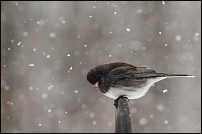 Naturalist Ariel Christian shares the story of a special, wintry bird:
Naturalist Ariel Christian shares the story of a special, wintry bird:
No one says “winter is here” quite like the little, gray songbird we call the dark-eyed junco. You may have seen this sparrow also known as the “snowbird” flutter by your window or shifting the fallen leaves in your backyard. When these feathered friends arrive in Wisconsin from the coniferous forests of Canada, we can also prepare to welcome the cold winds of winter on their wings. After I witnessed the first sign of junco activity outside the window of the Welcome Center, I knew there would be layers of snow covering the white pine trees here at Upham Woods soon after.
Of the many subspecies and color patterns of dark-eyed juncos found throughout the country, the slate-gray junco is the bird to visit us in Wisconsin from October through March. This bird is easy to identify with its dark gray head, body and tail and white belly. This sparrow has a sharp, finch-like beak specifically for cracking seeds. Juncos spend about 65% of their time on the ground sifting through forest debris and snow for hidden seeds. After their spring migration north, juncos will mostly eat insects and sometimes berries. Juncos will even nest on the ground, which are grass-lined depressions made by the females.
While other birds will squawk for annual feeders to be filled, juncos will happily chatter on the ground picking up fallen and forgotten seeds. Try putting some millet out if you want juncos to fill up at your feeder this winter. And remember, if you need more serenity to your life, watch this sweet, little sparrow and learn the song of this snowbird.



